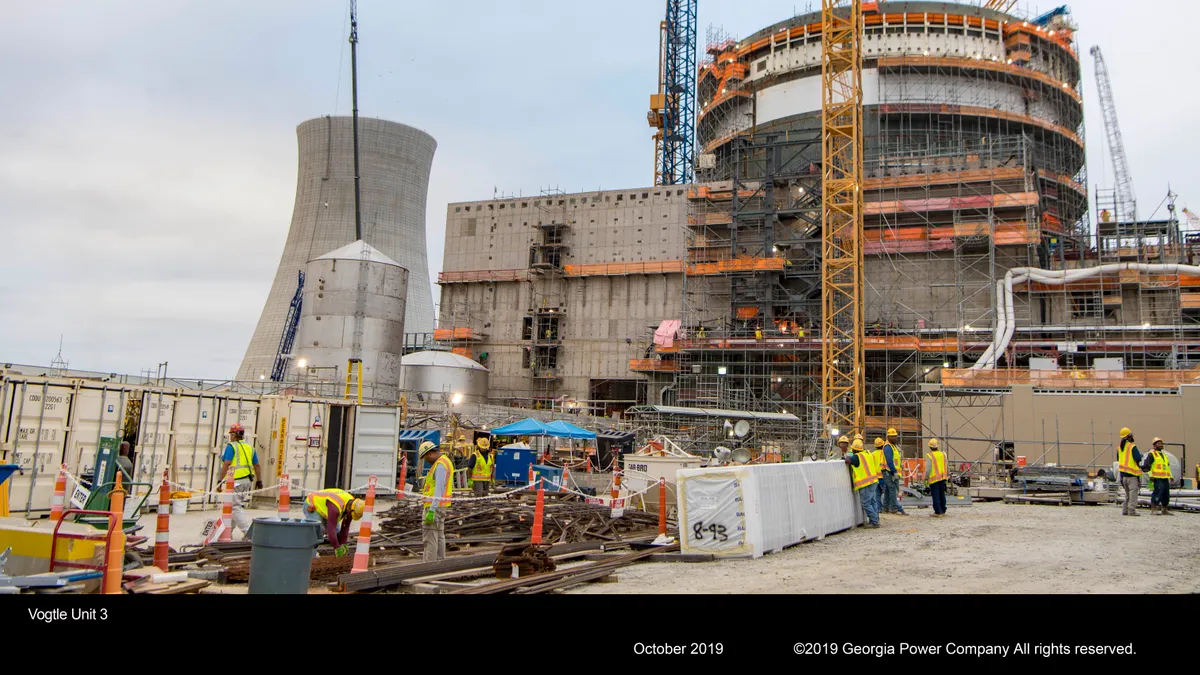Dive Brief:
- Southern Company officials called 2019 an "outstanding year" in a call with analysts on Thursday, crediting progress in work to complete two new reactors at subsidiary Georgia Power's Vogtle nuclear plant, and to further reduce the use of coal-fired generation.
- Southern saw year-over-year retail electricity sales decline 6.8% in the fourth quarter of 2019, as energy efficiency, lagging economic growth and the sale of Gulf Power reduced customer demand. Residential sales slid 13.9% compared the the final quarter of 2018, while commercial and industrial sales fell 8.3% and 7.2%, respectively.
- Southern reported Q4 2019 operating revenues were $4.91 billion, a decrease of 7.9% from last year. However, analysts had been looking for revenues closer to $5 billion from the company.
Dive Insight:
Southern "accomplished all major milestones" in 2019 related to the development of new nuclear generation at Vogtle and remains on track to bring Units 3 and 4 online in late 2021 and 2022, company Chairman, President and CEO Thomas Fanning told analysts.
The company started some facilities testing in November, and says the main control room was ready for testing in December. Southern has also submitted all uncompleted Inspections, Tests, Analyses, and Acceptance Criteria Notifications to the U.S. Nuclear Regulatory Commission, and has ordered fuel for Unit 3.
The total Vogtle project is now 84% complete, with direct construction of Unit 3 at 85% and direct construction of Unit 4 63% complete, officials said.
"We have refined our aggressive site work plan for the project," Fanning said, adding that a review of the project confirmed no change to the projected capital expenditures.
Total costs of the Vogtle nuclear plant expansion could exceed $25 billion dollars, the company has said. When proposed in 2008, the new units were estimated to cost about $14 billion.
The company says the nuclear expansion is an important part of efforts to decarbonize its generation. In 2018, Southern pledged to reduce carbon emissions 50% relative to 2007 levels by 2030 and set a long-term goal of low- to no-carbon operations by 2050.
Last year Southern decreased coal generation by 2,000 MW, and says the fuel now makes up just 22% of its energy production. Renewable generation is now 12% of Southern's energy mix, with nuclear and natural gas making up 16% and 50%, respectively.
"Before I was CEO, we were 70% coal and 0% renewables," Fanning told analysts.
Now, 14% of Southern's revenues come from coal generation, the company said.
"They have done a lot," Stephen Stetson, Sierra Club senior campaign representative, said of Southern's progress. "But they should be doing a lot more."
Southern has made significant decarbonization strides relative to other utilities, Stetson told Utility Dive. But he was critical of the company's plan to use more natural gas, including a new proposed plant in Alabama, and said its carbon capture ideas depend on "technology which does not exist yet." The company's Mississippi subsidiary had attempted to scale up carbon capture technology for a coal plant, but Southern eventually pulled the plug on the Kemper project when costs increased exponentially.
"We'd like to see them go faster and retire the rest of their coal fleet as fast as possible," Stetson said. However, "they are trending in the right direction."
Stetson said the company has three remaining coal plants in Alabama, three in Georgia and two in Mississippi.
Southern said it expects its generating fleet to have over 15,000 MW of renewable resources by 2022.
Retail sales declined
According to the company's earnings presentation, Southern added 41,000 residential electric and 30,000 residential gas customers in 2019, additions driven by strong job and population growth in the Southeast. In the fourth quarter, Southern reported $440 million, or $0.42/share, of earnings, compared with $278 million in the same quarter the previous year.
While retail sales declined, Southern said on a weather-normalized basis retail electric sales have been "essentially flat over the past five years."
Southern has seen annual customer growth of roughly 1%, offset by a decrease in customer usage of about the same percentage, reflecting continued improvements in energy efficiency, Southern CFO Drew Evans told analysts.
In 2019 specifically, Evans said the company "saw a trend of weaker industrial sales. This resulted largely from global trade uncertainty, as well as changes in production levels and customer responses to real-time pricing."
Wholesale electricity sales climbed 3.2% in the fourth quarter.
The company is expecting some pickup in deliveries, however.
"We do see some modest improvements emerging, as we believe the Southeast is well-positioned to add customers as the industrial sector picks up," Evans said.
Retail electricity sales are forecast to be flat to 1% growth for the foreseeable future, according to the company.














